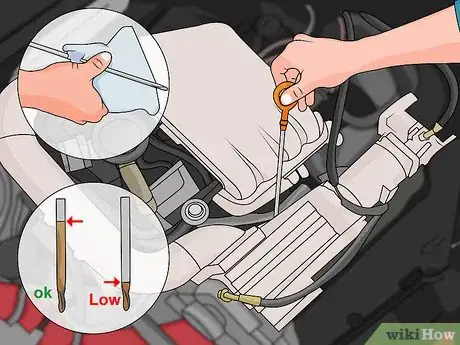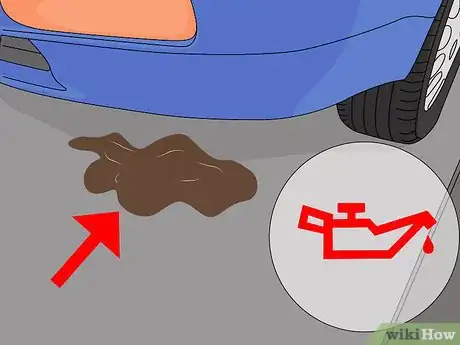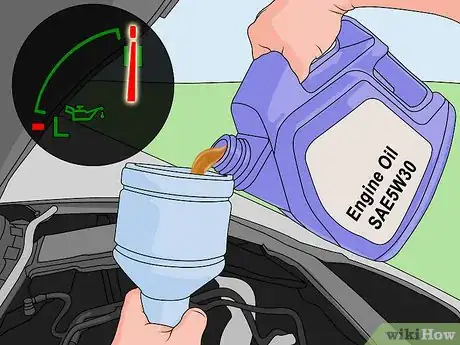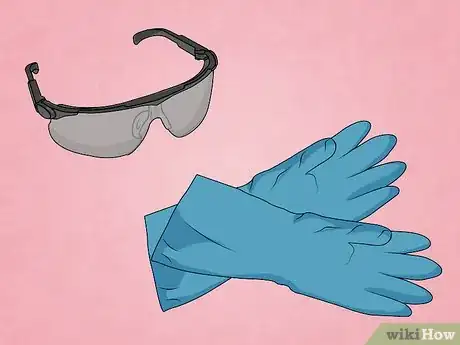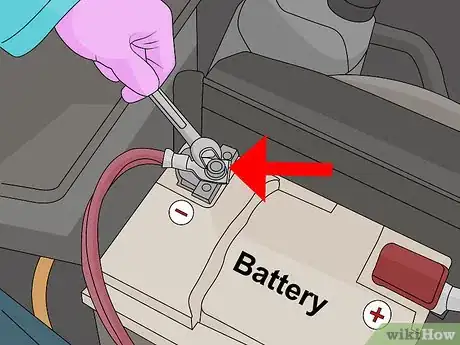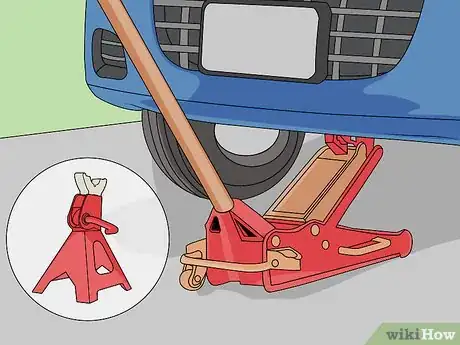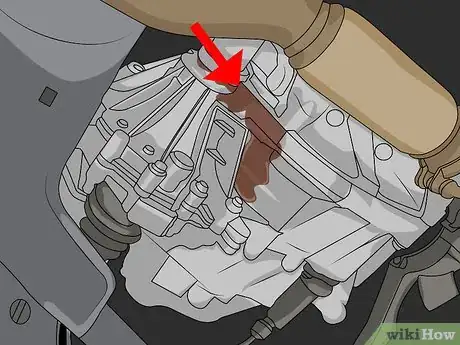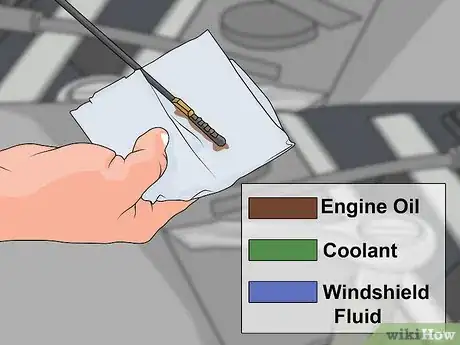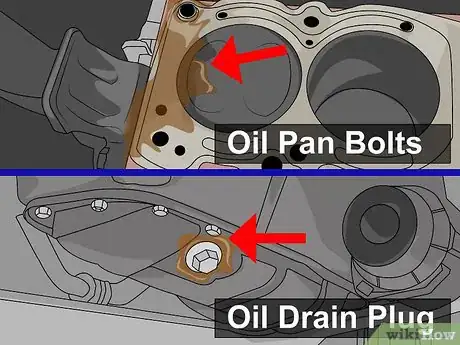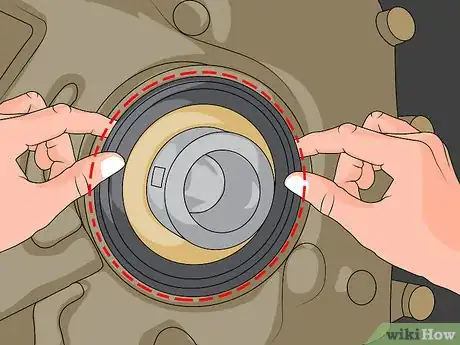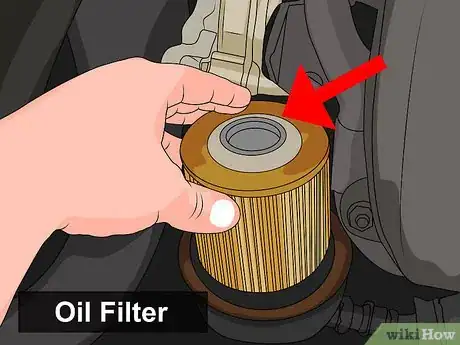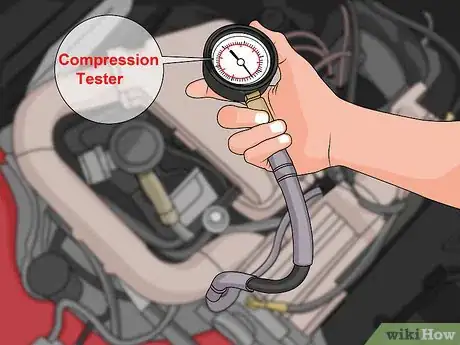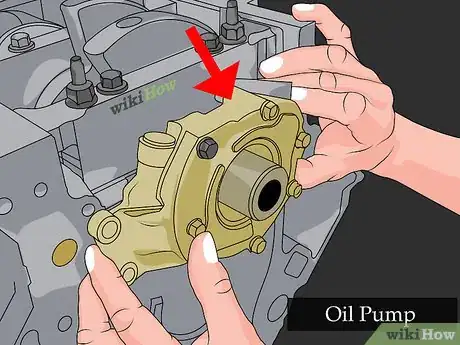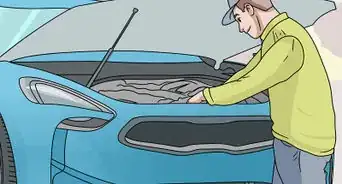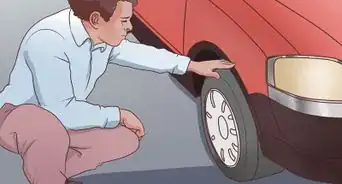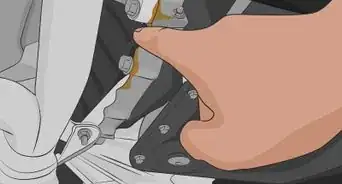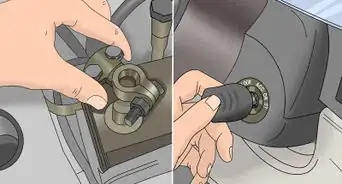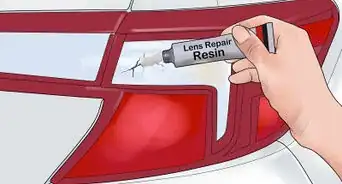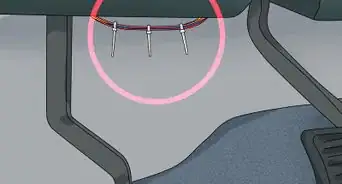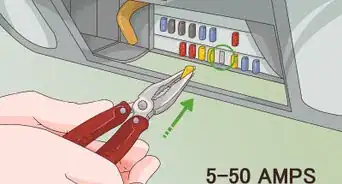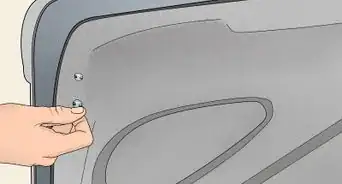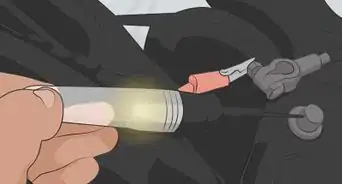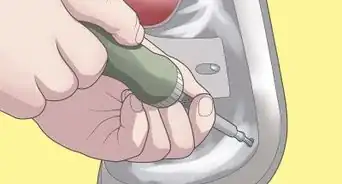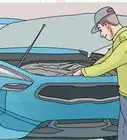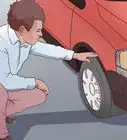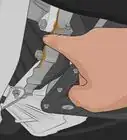This article was co-authored by Tom Eisenberg. Tom Eisenberg is the Owner and General Manager of West Coast Tires & Service in Los Angeles, California, a family-owned AAA-approved and certified auto shop. Tom has over 10 years of experience in the auto industry. Modern Tire Dealer Magazine voted his shop one of the Best 10 Operations in the Country.
There are 10 references cited in this article, which can be found at the bottom of the page.
wikiHow marks an article as reader-approved once it receives enough positive feedback. In this case, 83% of readers who voted found the article helpful, earning it our reader-approved status.
This article has been viewed 525,212 times.
If your oil light comes on while you’re driving, it means there has been a drop in the oil pressure in your engine. Your engine requires a steady supply of oil to keep all of its moving parts lubricated and cool,[1] so it’s important not to let the vehicle run for long with insufficient oil pressure. Driving without the necessary level of oil under the proper amount of pressure can result in extensive damage to your engine. When your oil light pops on, taking swift action can save thousands of dollars in future repairs.
Steps
Preventing Mechanical Damage
-
1Pull over to the side of the road and shut off the engine. When your engine oil light comes on, you should look for a safe opportunity to pull the vehicle over immediately. Continuing to run the engine with insufficient oil to lubricate the moving parts can result in catastrophic damage to the internal components of your engine, but your safety and the safety of those around you should be your first concern. Shut the car off as soon as you are safely on the side of the road.[2]
- Pull the vehicle over and shut it off as quickly as you can do so safely.
- The longer the engine runs with low oil pressure, the greater the likelihood that damage is occurring inside the engine.
-
2Check the oil level with the dipstick. Once you are safely on the side of the road, pop the hood and check the oil level in your vehicle’s engine using the dipstick. Locate the dipstick in the engine bay and remove it, wipe off the oil that is on the indicator at the end of the dipstick using a rag or napkin, then slide the dipstick back into the tube it came from. Now remove the dipstick again and look at the amount of oil on the indicator.[3]
- Look at how far up the indicator the wet oil line reaches.
- Each line below the “full” line indicates a quart of oil the engine is low.
- If the oil line reaches the second line below the “full” line, it means the engine is short two quarts of oil.
Advertisement -
3Look for signs of a leak. If there was the appropriate amount of oil in your engine before, but the level is now far too low, it means the oil either leaked out of the vehicle or was burned by the engine due to an internal leak. Look under the car for any indications of an oil leak. If you see oil dripping down from the engine below the car, it likely means a gasket has ruptured or the oil filter is not securely fastened to the vehicle.[4]
- Be careful, the oil leaking from the engine is likely extremely hot.
- If you do not see any signs of a leak and the oil level was not too low, the problem may not be a lack of oil, but a lack of oil pressure.
-
4Add oil if it’s low and check the oil light. Your oil light may have come on because there wasn’t enough oil in the system to maintain adequate oil pressure. Purchase the same kind of oil the vehicle already has in it, paying attention to the weight of the oil (5w30, 10w30, etcetera) and add enough to bring the dip stick oil indicator back to full. Start the engine, and see if the oil light is still on.[5]
- If the oil light stays off, it means your engine was low on oil. You will need to assess where the oil went, but can safely drive the vehicle as long as the oil doesn’t leak out of the engine too quickly.
- If the oil light comes back on, shut the engine back down.
-
5Do not drive the vehicle if the oil light comes back on. If you add oil and the light comes back on, it means the issue is oil pressure, not the amount of oil. Oil pressure is created by the oil pump forcing the oil through the engine. If the pump fails to function, the engine will not be properly lubricated and running it will cause damage.[6]
- If the oil light stays on, you will need to have the vehicle towed to your house or a repair facility.
- Do not drive the vehicle with the oil light on if at all possible.
Addressing Oil Leaks
-
1Put on the appropriate safety gear. Before you do any kind of work or maintenance on your vehicle, it’s important that you first put on the necessary safety gear. Checking for oil leaks means climbing under the vehicle where oil will likely be dripping from above you, so eye protection is absolutely necessary. You may also choose to wear gloves to protect your hands from pinches, scrapes, or the radiant heat of the engine bay.[7]
- Eye protection such as glasses or goggles are a requirement for this project.
- Gloves are not mandatory but you may choose to wear them.
-
2Disconnect the battery. Before jacking up the car, pop the hood and disconnect the battery to ensure the engine cannot be started for any reason while you are under the vehicle. Use a hand or socket wrench to loosen the bolt securing the black ground cable to the negative terminal on the battery. The negative terminal can be identified by the letters “NEG” or the negative symbol (-) above the terminal.[8]
- Remove the ground cable from the negative terminal and tuck it to the side of the battery.
- You will not need to remove the cable from the positive terminal.
-
3Use a jack to raise your vehicle, then use jack stands to support it. Make sure the car is on solid blacktop or concrete and use a jack to raise the vehicle to a height that allows you to climb or use a creeper to slide under it. With it at the appropriate height, place jack stands under the car in designated jacking points to support the weight of the vehicle.[9]
- Never just use a jack to support the weight of a vehicle you climb under.
- If you are unsure of where to place the jack or jack stands, check in your vehicle’s owner’s manual for designated jack points.
-
4Look for signs of the oil leak. Look around the engine from above and below for signs of an oil leak. There may be a small leak that allowed the oil to leak out over time or there may be a more significant leak that happened quickly. Because the oil system is under pressure, a large leak will result in oil being sprayed all over the area of the leak.[10]
- If you see a small stream of oil running down a surface in the engine bay, follow it up to its highest point to locate the point of the leak.
- If there is a lot of oil everywhere, the leak is likely substantial.
-
5Ensure fluids you locate are oil. There are a number of different fluids found in the engine of modern vehicles and it can be difficult to determine which fluid you’ve encountered while looking for leaks. Oil is usually brown or black, while coolant tends to be orange or green and windshield washer fluid is usually blue. However, once mixed with the dirt and grime of your engine bay, the color of the fluid may be difficult to assess. Wipe some of the fluid on a blank sheet of white paper to get a better idea of its color.[11]
- Make sure the engine is cool before starting this process to avoid being burned by dripping fluids.
- Look for brown or black fluids when searching for oil leaks.
-
6Check the common locations for leaks. When looking for oil leaks, you may want to start at the common gasket failure points. Engines are made up of metal components bolted together, but simply bolting two pieces of metal to each other will not create a seal that can withstand the oil pressure in your engine. Because of this, automakers add gaskets at these locations to create a seal. If a gasket becomes compromised, the pressure of the oil will force the oil out the weak point and create a leak. While these common locations can be a good place to start, this is far from an exhaustive list of places you may find an oil leak.[12]
- Look at where the oil pan bolts to the bottom of the engine block. The pan is the lowest point in the engine and is held in place by a number of bolts. Run your finger along the oil pan to identify where a leak may have started.
- Check the oil drain plug on your oil pan to ensure it is snug and no oil is leaking from it.
- Look for signs of oil leaking where the cylinder head meets the block (head gasket) and where the cover bolts to the top of the cylinder head (valve cover).
- Leaks may also arise where the crankshaft bolts to the crank pulley on the bottom of the engine block.
-
7Replace failed gaskets causing leaks. Once you identify the location of an oil leak, you’ll need to take corrective action to stop the leak from continuing. Locate the leak, then remove the component in place over the failed gasket. Scrape off any remnants of the old gasket before replacing it with a new one and bolting the component back into place. Some gaskets are simple and easy to replace, while others may require the removal of the engine from the vehicle. Assess whether or not the repair is something you are capable of doing, as you may need to have a professional mechanic repair the leak.[13]
- If you can identify the leak, but lack the tools or expertise to repair it, bring it to a mechanic and let them know what you were able to identify.
- You can purchase replacement gaskets at your local auto parts store.
Assessing Other Oil Pressure Issues
-
1Replace the oil filter. If you have gone a long time since your last oil change, it’s possible that your oil filter has become too clogged to allow oil to flow through it properly. Address this by draining the oil from the engine, replacing the oil filter, and refilling the engine with new oil. If the old oil filter would not permit oil flow, the light will turn off when you start the engine with a new filter and oil pressure should return to normal.[14]
- If the oil light does not come back on and the oil pressure gauge reads properly then the issue is resolved.
- If the light comes back on, turn the engine off immediately.
-
2Do a compression test on the engine. If your engine’s oil was low but there is no sign of a leak, it likely means the engine is burning oil. The engine’s oil should not be able to enter the cylinder to be ignited with the air and fuel mixture, so burning oil means a seal in your engine has been compromised enough to allow oil to seep past it. Two common locations of increased clearance are the valve guides and piston rings. If these have worn enough to allow oil to pass through them, it also will limit the amount of compression the leaking cylinder is capable of.[15]
- Purchase a compression gauge and insert it into the first cylinder’s spark plug hole to conduct a compression test. Repeat the process with each cylinder.
- Have a friend crank the engine as you assess the maximum reading on the gauge.
- If one cylinder reads as lower than the others, that cylinder has compromised rings or valve seals. The engine will require significant repairs.
-
3Check the oil pressure sending unit. Locate the oil pressure sending unit and disconnect the wiring giving it power. Look to see if that has any effect on the oil pressure gauge in your vehicle. If it does not, it is likely that the issue is not an actual oil pressure problem, but rather a problem with the sensor reading that pressure.[16]
- Check in your vehicle’s service manual to locate the oil pressure sending unit, as it may be located in a number of places depending on the make and model of your vehicle.
- If the gauge does not move when the sending unit is disconnected, the engine’s oil pressure may actually be fine.
-
4Replace the oil pump. Oil pumps technically don’t produce oil pressure, but rather they produce flow and it’s the resistance the oil runs into along its path that creates the pressure. With that in mind, a faulty oil pump can reduce the engine’s ability to create oil pressure. If you choose to replace the oil pump yourself, make sure to use the correct gasket or you may create a significant oil leak. Installing a new oil pump can be a big project, so unless you have the tools and expertise, it may be best left to professionals.[17]
- Use the correct installation tool for your vehicle when seating the oil pickup tube into the pump. Forcing it can cause damage.
- Add oil to the pump before you install it to ensure it is properly primed before the engine is started once it’s in place.
References
- ↑ Tom Eisenberg. Auto Technician. Expert Interview. 26 July 2019.
- ↑ http://www.popularmechanics.com/cars/how-to/a7623/why-does-your-cars-oil-light-come-on-8657725/
- ↑ https://www.yourmechanic.com/article/is-it-safe-to-drive-with-the-oil-light-on
- ↑ https://www.yourmechanic.com/article/is-it-safe-to-drive-with-the-oil-light-on
- ↑ http://repairpal.com/low-oil-pressure-warning-light
- ↑ http://repairpal.com/low-oil-pressure-warning-light
- ↑ http://www.dummies.com/how-to/content/how-to-safely-jack-up-your-vehicle.html
- ↑ http://www.popularmechanics.com/cars/how-to/a1454/4213127/
- ↑ http://www.dummies.com/how-to/content/how-to-safely-jack-up-your-vehicle.html
- ↑ http://www.popularmechanics.com/cars/how-to/a106/1272471/
- ↑ http://www.popularmechanics.com/cars/how-to/a106/1272471/
- ↑ http://www.howacarworks.com/engine/checking-for-oil-leaks
- ↑ http://www.howacarworks.com/engine/checking-for-oil-leaks
- ↑ http://www.aa1car.com/library/us1097.htm
- ↑ http://www.aa1car.com/library/us1097.htm
- ↑ http://www.aa1car.com/library/us1097.htm
- ↑ http://www.aa1car.com/library/us1097.htm
About This Article
If your car's oil light has come on, pull over to the side of the road and shut off the engine. You'll need to inspect the car to ensure that there are not any mechanical issues. Open the hood of your car and check the oil level with the dipstick. If it is low, add oil as quickly as you can and look underneath your car for signs of a leak. Once you've added oil, check the oil light to see if it has turned off. If it hasn't, you should take your car to a mechanic or auto parts store to see why the light is on. To learn how to do a compression test on the engine, scroll down!


